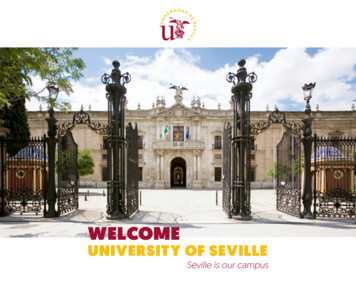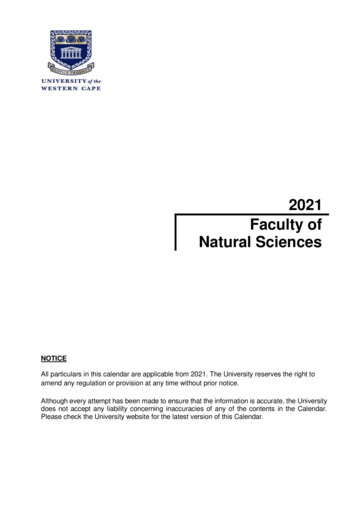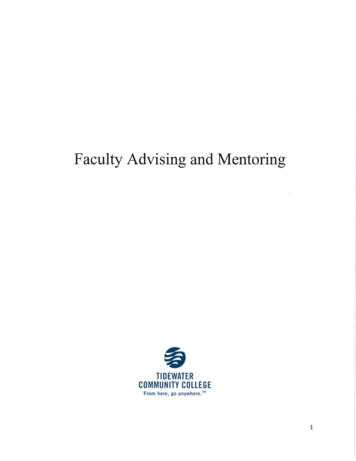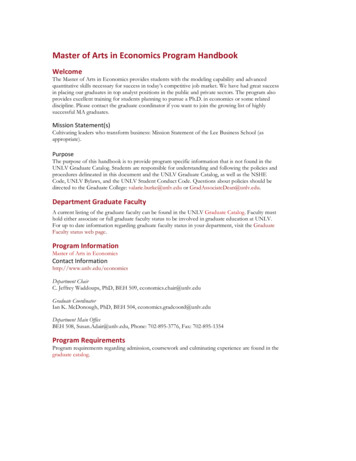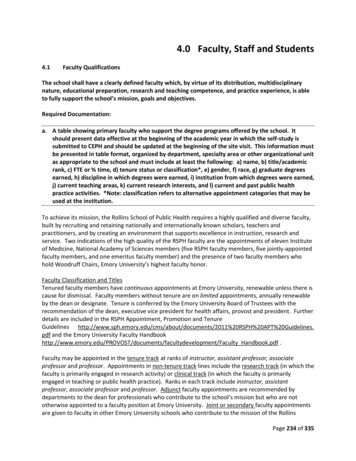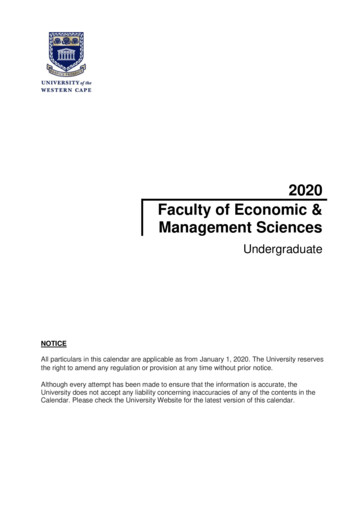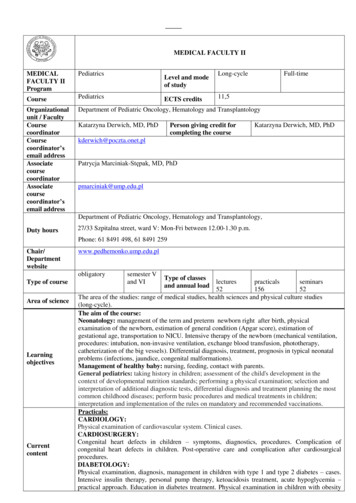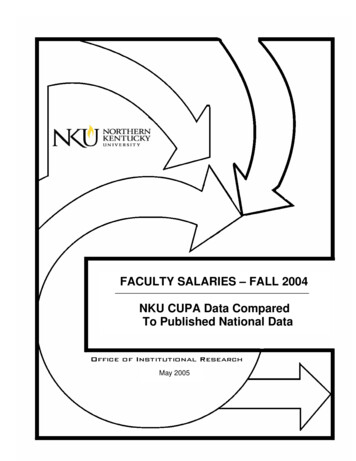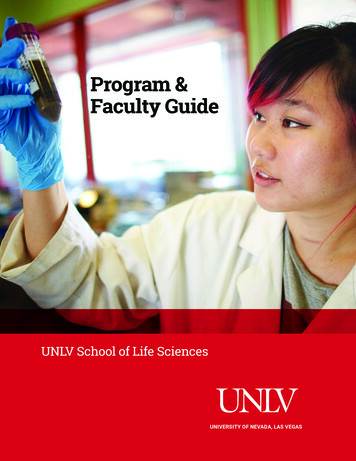
Transcription
Program &Faculty GuideUNLV School of Life SciencesUNIVERSITY OF NEVADA, LAS VEGAS
ContentsFrom the Director . 3About UNLV . 4Programs . 5Facilities . 7Graduate Students .11Postdoctoral Scholars .13Faculty Researchers . 15UNLV School ofLife Sciences
From the DirectorThe School of Life Sciences (SoLS) is one of thelargest academic units on the University of Nevada,Las Vegas (UNLV) campus. It has 30 full-time facultymembers, 10 adjunct and research faculty, more than1,900 undergraduate majors, and approximately 55graduate students. The school’s offices and laboratories are located in four buildings: Juanita Greer WhiteHall (WHI), the Science and Engineering Building(SEB), the White Hall Annex (WHA2), the Campus LabBuilding (CLB). Research facilities on campus includecenters for bioinformatics/biostatics with accessto supercomputer facilities, confocal and biologicalimaging core with a new a high-speed laser-scanningmicroscope, genomics center, greenhouses, tissueculture facilities, environmental chambers and modern animal care facilities.The faculty research and graduate programs are organized into Bioinformatics, Cell & Molecular Biology,Ecology & Evolutionary Biology, Integrative Physiology,School of Life Sciences Director Frank van Breukelenand Microbiology. SoLS faculty are recruited fromsome of the best research institutions and currently collaborate with the Nevada Instituteof Personalized Medicine (NIPM), Lou Ruvo Center, Desert Research Institute (DRI), BLM,USGS, US National Park Service, and with faculty and researchers at many universities andgovernment agencies throughout the nation and international institutions, providing expanded opportunities for our students. The faculty compete successfully for funding fromBLM, DOE, DOI, FWS, NASA, NIH, NSF, USDA, USGS and other agencies. Given the high research productivity, the high current and potential synergy with important regional entities,and the large number of majors, the School of Life Sciences is uniquely poised to contributeto the UNLV Top Tier Goals.The UNLV campus is located near the intersection of the Mojave, Sonoran, and GreatBasin deserts and is also situated in close proximity to broad elevation gradients (6003600m) with snowcapped mountains in the winter. Within a one-hour drive are numerousrecreation and scenic areas, including two National Recreation Areas (Lake Mead andSpring Mountain), Red Rock Canyon Natural Conservation Area, and Valley of Fire StatePark. Within a three to five hour drive are many other natural areas, including severalfamous National Parks (Death Valley, Grand Canyon, Zion, Bryce).Las Vegas is best known as a center for entertainment and recreation and is a rapidly growing Southwestern city with a broad economic and cultural base. UNLV is an integral part ofthe Las Vegas culture and environment with nationally recognized musical, dramatic, dance,and artistic performers regularly visiting campus. Several popular lecture series bring inwell-known politicians, newsmakers, and scientists. The 135-ha campus is characterized bymodern facilities, and surrounded by both traditional lawns and desert landscaping.3
About UNLVSince its first classes were held in 1957, the University of Nevada, Las Vegas (UNLV) has transformedfrom a small branch college into a thriving urban research institution. Along the way, UNLV has become an indispensable resource in one of the country’s fastest-growing and most enterprising cities.Today, UNLV is a doctoral-degree-granting institution of nearly 30,000 students, 3,000 faculty and staff,and more than 100,000 alumni. A federally designated Minority Serving Institution, UNLV has nationallyrecognized programs in the arts, sciences and health sciences, hospitality, law, and liberal arts.MissionThe University of Nevada, Las Vegas is a public research institution committed to rigorous educational programs and the highest standards of a liberal educationUNLV’s Top Tier MissionUNLV’s diverse faculty, students, staff, and alumni promote community well-being and individualachievement through education, research, scholarship, creative activities, and clinical services.We stimulate economic development and diversification, foster a climate of innovation, promotehealth, and enrich the cultural vitality of the communities that we serve.DiversityAt UNLV, we have come together and created one of the most affirmative and dynamic academicenvironments in the country. UNLV continues to rise in U.S. News & World Report’s annual listingof the nation’s most diverse universities for undergraduates. The university is tied for first in thepublication’s annual Best Ethnic Diversity listing. UNLV has placed in the top 10 for the past sixyears and continues to show our commitment to serving our wonderfully diverse population andbuilding the future for Las Vegas and Nevada.UNLV is accredited by the Northwest Commission on Colleges and Universities.4
ProgramsBachelor of Science in Biological SciencesBiology is the study of life. The earth is filled with an enormous variety of living organisms; therefore,an understanding of the basic biological processes common to all organisms is essential to understanding the world. In recent decades, great strides have been made in understanding importantbiological processes, particularly those at the molecular, cellular, and ecosystem levels. An understanding of biological systems depends, in part, on the principles of physics and chemistry; thusa firm background in the physical sciences is also important in the study of biology. For many, anundergraduate major in biology (Bachelor of Science (B.S. Degree)) serves as a basis for postgraduate study in the life sciences. School of Life Sciences graduates have gone on to advanced graduatestudy, leading to careers in college or university teaching, basic and applied research, and publichealth. Many have entered professional programs in medicine, veterinary medicine, and dentistry.Other graduates have gone directly into secondary (high school) science teaching, the biomedical industry, independent laboratory research, natural resources management, or environmental education.The Biological Sciences undergraduate degree program aims to diversely train its students, enablinggraduates to pursue careers or advanced degrees in life and health sciences, research, education,industry, or governmental work. Based on their individual interests, students may select from thefollowing concentrations: Cell and Molecular Biology, Ecology and Evolutionary Biology, IntegrativePhysiology, Microbiology, and Pre-Professional Studies. All biology undergraduate students mustcomplete a minimum of 120 credit hours. Each concentration may require specific upper divisioncourses; therefore the number of upper division electives may vary across concentrations.Master of Science in Biological SciencesThe Master of Science (M.S.) degree in Biological Sciences within the School of Life Sciences (SoLS)consists of four sectional research concentrations that reflect the scope of modern biology: Ecologyand Evolutionary Biology (EEB), Integrative Physiology (IP), Cell and Molecular Biology (CMB), Microbiology (MB), and Quantitative Biology and Bioinformatics (QBB). The degree is research centeredand requires the defense of a thesis that describes a novel research project that can serve as the basisfor the publication of at least one paper in a peer-reviewed journal. The M.S. degree in Biological Sciences prepares students for careers in education, government, and industry as well as preparing themfor more advanced degrees in the life sciences. Students must complete a minimum of 30 credit hoursfrom a list of core and approved courses within their section.All students graduating with a Master’s of Science in Biological Sciences should be able to: Master a critical set of key concepts specific for each sectional concentration. Become familiar with key methodologies specific for each sectional concentration. Comprehend and critically evaluate the current published scientific literature. Engage in scientific research in which the individual can formulate hypotheses, generate highquality data, and evaluate that data for reasonable scientific conclusions. Communicate scientific results effectively in oral presentations to general and specializedaudiences. Communicate scientific results effectively in written reports suitable for publication. Instruct and engage students and members of the community at all levels to appreciate theimportance of biology in their lives.5
Programs ContinuedDoctor of Philosophy in Biological SciencesThe Doctor of Philosophy (Ph.D.) in Biological Sciences within the School of Life Sciences (SoLS)consists of four sectional research concentrations that reflect the scope of modern biology: Ecologyand Evolutionary Biology (EEB), Integrative Physiology (IP), Cell and Molecular Biology (CMB),Microbiology (MB), and Quantitative Biology and Bioinformatics (QBB). The degree is research intensive and designed to prepare students for careers in academia, government, and industry as engagedscholars who are experts in their chosen field. Students must complete a minimum of 60 credit hoursfrom a list of core and approved courses within their research section. They must engage in independent research that is novel and exciting culminating with a dissertation that makes an important contribution to their chosen field. As such, it is expected that their dissertation work will be published inpeer reviewed journals with the student listed as first author. Successful students are also trained andexpected to develop as effective teachers and educators, and each student must serve as a teachingassistant for two semesters as part of the degree program.All students graduating with a Ph.D. in Biological Sciences should be able to:6 Master a critical set of key concepts specific for each sectional concentration. Gain expertise with key methodologies and experimental techniques specific for each sectionalconcentration. Read, comprehend, and critically evaluate the current published scientific literature. Evaluate a scientific question and formulate testable hypotheses. Independently design experiments to effectively test hypotheses. Generate and collect reproducible data. Access up-to-date methods for analyzing and tabulating data. Communicate scientific results effectively in oral presentations to general and specialized audiences. Communicate scientific results effectively in written reports for publication in peer-reviewed journals. Apply and be competitive for extramural monies to fund research. Instruct and engage students and members of the community at all levels to appreciate theimportance of biology in their lives.
FacilitiesBiocomputing CenterThe Biocomputing Center supports the teaching and research missions of faculty at the School ofLife Sciences and their associates in bioinformatics, biostatistics, biomathematics and biomodelling. Located in Room 204, Juanita Greer White Hall, this center is equipped with servers andwork stations and is directly linked to the supercomputer clusters in the National Supercomputing Institute on campus (https://www.nscee.edu/). Software available for research and teachingincludes Matlab (with Bioinformatics, Statistics, and Simulation Biology modules), Mathematica,CLC Genomics Workbench, and free, open source packages such as MACS, Trinity, Bowtie/Tophat/Cuffdiff/CummeRbund, and HISAT/StringTie/Ballgown. The center fosters collaborations amongfaculty members and students for analyzing “big data” from Next-Generation Sequencing (RNAseq, Chip-seq, and Exome sequencing), Genome-Wide Association Studies, Network Analyses, andmodeling of water transport in plants. The software at the Center can also be used in general foraddressing a wide variety of models based on ordinary or partial differential equations.UNLV Confocal and Biological Imaging CoreLaser scanning microscopy (LSM) has revolutionized our ability to investigate complex biologicalprocesses with light microscopy. These capabilities have vastly broadened the scope of questions being addressed in biological systems to the extent that LSM has become a basic tool forthe advancement of research. The UNLV Confocal and Biological Imaging Core (CBI Core) is afee-for-service, multi-user facility committed to providing access to both confocal and multiphoton microscopy for all Nevada researchers. The Confocal and Biological Imaging Core has hada profound impact on infrastructure and enhances our ability to develop innovative and timelyresearch products. Current users are from research groups in the UNLV College of Engineering,College of Liberal Arts, College of Nursing, and College of Sciences.The current instrument is a state-of-the-art Nikon A1R CLSM with a resonance scanner for highspeed imaging of living samples and spectral unmixing for advanced applications. This systemis mounted on a Nikon Eclipse Ti body equipped with a CLSM imaging resonance scanner, forrapid acquisition of images from living samples. Two additional digital imaging systems areavailable for epifluorescence and other types of light microscopy: a high resolution charge-coupled device (CCD) and a highly sensitive electron-multiplying CCD (EMCCD). The CBI core operates a separate image processing workstation that runs the commercial image processing andanalysis application Volocity. A multiphoton fluorescence microscope system will be installed inearly 2018.The core operates both as a shared instrument facility and re-charge center. Every new usermust demonstrate proficiency with the CLSM before receiving access to the facility. A web-basedreservation program is used to schedule time in the Imaging Core. User fees are revised on ayearly basis, and assessed quarterly. The microscope is located in the UNLV Science and Engineering Building.UNLV Genomics Core FacilityThe UNLV Genomics Core Facility is a non-profit recharge laboratory designed to aid biomedical,biotech, and genomic research endeavors by providing users with access to essential instrumentation, services and technical expertise at the lowest cost possible. The UNLV Genomics Facility is7
Facilities Continueddesigned to aid researchers in studying the properties and functions of genes and their products.Our goal is to provide quality, timely, and reliable services to research laboratories and to serve asa training platform for scientists wishing to learn nucleic acid and protein techniques. Our servicesinclude: ABI 3130 DNA Sequencing, Affymetrix GeneChip Microarray, Agilent 2100 BioanalyzerRNA analysis, BD FACSCalibur Flow Cytometry.We also offer a wide variety of state-of-the-art equipment on either a recharge basis, or free ofcharge. We are committed to helping scientists from all disciplines in life science take advantage of our services in order to answer questions enabled by genomics approaches. The UNLVGenomics Core Facility is a non-profit recharge laboratory designed to aid biomedical, biotech,and genomic research endeavors by providing users with access to essential instrumentation,services and technical expertise at the lowest cost possible.GreenhouseThe SEB greenhouse is a core facility with four individually controlled bays and a communalheadhouse. The headhouse contains the controls for an iGrow system that monitors the environment and adapts the mechanical systems to control conditions in each bay. The iGrow systemuses information from its outside weather station and sensors in each bay to predict energyload. The program then calculates the best way to maintain a stable environment in each baywith minimal fluctuation. A system manager can also make changes remotely to each bay tohelp maintain or change conditions. In the event of a system failure and environmental conditionfalls outside of required specifications, the greenhouse is wired to the SEB Programmatic AlarmSystem which sends out an alarm so research will not be lost. The headhouse also containsspace for small storage of items and work benches for preparation of materials.8
Facilities ContinuedThe greenhouse bays each contain sensors monitoring temperature and humidity so the iGrowsystem will be able to monitor and adjust conditions to remain within user defined specifications.Bays are also equipped with domestic and RO water systems, movable benches and retractablesolar shades.UNLV National Supercomputing InstituteTo provide computing, networking, and supercomputing resources for support of academic andresearch programs of Nevada’s universities, community colleges, secondary and primary schools,advanced technology companies, and local, state and federal governmental agencies. To providehigh-performance computing and networking resources for research and development programsrequiring collaboration at the state, national and international levels. To facilitate high-technologyeconomic diversification in Nevada by providing services not available in the private-sector andby promoting partnerships between university faculty and external entities.In collaboration with Switch Communications and Cisco, there is a dedicated high-speed networkavailable for research users. Currently, the research network connects the UNLV NSI data centerslocated in the UNLV Science and Engineering Building with our resources at SWITCH’s SUPERNAP7colocation facility. This connection consists of an aggregated 200Gb/s link over dedicated fiber.There is also a 10Gb/s connection to the Internet. In collaboration with Intel, Penguin Computing,and Switch Communications, the Cherry Creek supercomputer is now available for use.Wesley E. Niles HerbariumThe Wesley E. Niles Herbarium is a collection of dried, pressed plant specimens mounted on sheets ofarchival paper, enclosed in species folders, and stored in airtight, metal cabinets for future reference9
Facilities Continuedand long-term preservation. These specimens andthe collection data accompanying them providedocumentation for the past and present occurrence, distribution, and diversity of flowering plants,conifers, and mosses in the southwestern UnitedStates, especially the deserts and mountains of theMojave ecoregion. The herbarium also serves asa center for research and teaching, and providesbotanical support to governmental agencies and tothe general public.Dr. Wesley E. Niles (now faculty emeritus)founded the herbarium in 1970 soon after he arrived at UNLV. Four years after its inception, theherbarium was designated a “National ResearchCollection” by the Advisory Committee forSystematic Resources in Botany. Although 1200herbaria in the United States were surveyed atthe time, the UNLV herbarium was one of only105 to be judged as essential and of such importance that its “loss or inaccessibility” wouldcompromise taxonomic research in the UnitedStates and worldwide. It was the only herbariumin the state of Nevada and the Mojave ecoregion to be so designated.The herbarium currently is comprised of a vascular plant collection of approximately 65,000specimens, all of which are accessible in a digital database, and a smaller, but expanding collection of more than 4,000 bryophytes. As the herbarium grows in specimen numbers and value,its importance as a scientific resource has continued to extend beyond traditional taxonomicand systematic studies. It increasingly serves as a significant, if not an essential, resource forgenetic sampling, conservation biology, understanding biogeographic patterns, and addressingenvironmental concerns such as natural and anthropogenic disturbances and climate change.10
Graduate StudentsCellular and Molecular BiologyEcology and Evolutionary BiologyVictoria Amato - Ph.D. studentAdvisor: Jeffery ShenMaryam Hadi - Ph.D. studentAdvisor: Elizabeth StacyChenoa Wilcox - M.S. studentAdvisors: Scott Abella and JefJaegerHector Aviles - Ph.D. studentAdvisors: Jeffery Shen and NoraCaberoyElizabeth (Wendy) Jones - Ph.D.studentAdvisor: Donald PriceVictoria Wuest - M.S. studentAdvisors: Duane Moser andFrank van BreukelenSantiago Bataller - Ph.D. studentAdvisor: Jeffery ShenDebra Kerr - M.S. studentAdvisors: Jenifer Utz and Frankvan BreukelenTamara Wynne - Ph.D. studentAdvisor: Dale DevittCarolyn Koehn - M.S. studentAdvisor: Matthew PetrieIke Brown - Ph.D. studentAdvisor: David LeeMandy Mountain - M.S. studentAdvisor: Daniel ThompsonDylan Guerin - Ph.D. studentAdvisor: Kelly TsengRobert Pelletier - Ph.D. studentAdvisors: Frank van Breukelenand Jef JaegerCindy Kha - Ph.D. studentAdvisor: Kelly TsengAdrienne Bugayong - Ph.D. studentAdvisor: Nora CaberoyZach Carlson - Ph.D. studentAdvisor: Frank van BreukelenJennifer Clark - Ph.D. studentAdvisor: Allen Gibbs(Anton) Jose Garrido - Ph.D.studentAdvisor: Nora CaberoyRandolph Grell - Ph.D. studentAdvisor: Kelly TsengJesus Guerrero - M.S. studentAdvisor: Mo WengReina Koran - Ph.D. studentAdvisor: Mo WengSheila Mosallaei - Ph.D. studentAdvisor: Laurel RafteryLorena Samentar - Ph.D. studentAdvisor: Nora CaberoyAnne Villacastin - Ph.D. studentAdvisor: Jeffery ShenKeala Watson - M.S. studentAdvisor: Laurel RafteryNikki Pirtel - M.S. studentAdvisor: Matthew PetrieRebeca Rivera - M.S. studentAdvisors: Scott Abella and JefJaegerTomoko Sakishima - Ph.D. studentAdvisor: Elizabeth StacyIntegrative PhysiologyAmy Klink - Ph.D. studentAdvisor: Allyson HindleClaudia Silva Rubio - M.S. studentAdvisor: Frank van BreukelenEmma Weitzner - Ph.D. studentAdvisor: Allyson HindleMicrobiologyNeil Savage - M.S. studentAdvisor: Matthew PetrieKenesha Broom - Ph.D. studentAdvisor: Boo TsengKatie Schultz - M.S. studentAdvisor: Allen GibbsErin Cassin - Ph.D. studentAdvisor: Boo TsengAlaric Smith - Ph.D. studentAdvisor: Allen GibbsJonathan Covington - M.S. studentAdvisor: Brian HedlundCasey Stamereilers - Ph.D. studentAdvisor: Philippos TsourkasCody Cris - M.S studentAdvisor: Helen WingKristen Tovar - M.S. studentAdvisor: Daniel ThompsonMolly Devlin - Ph.D. studentAdvisors: Brian Hedlund andDuane Moser11
Graduate Students Cont.Microbiology ContinuedAriel Friel - Ph.D. studentAdvisor: Brian HedlundTaylor Gerson - Ph.D. studentAdvisor: Helen WingRobert Heron - M.S. studentAdvisor: Eduardo RobletoNancy Nou - M.S. studentAdvisor: Brian HedlundMelissa Schofield - Ph.D. studentAdvisor: Boo TsengCale Seymour - M.S. studentAdvisor: Brian HedlundJillian Socea - Ph.D. studentAdvisor: Helen WingNatasha Sushenko - M.S. studentAdvisors: Duane Moser andBrian HedlundCarmen Vallin - Ph.D. studentAdvisor: Eduardo Robleto12Quantitative Biology andBioinformaticsJelard Aquino - Ph.D. studentAdvisor: Mira HanDylan Barth - Ph.D. studentAdvisor: Mira HanDengxun Lai - Ph.D. studentAdvisor: Brian HedlundCorinne Sexton - Ph.D. studentAdvisor: Mira HanRichard Van - M.S. studentAdvisor: Mira Han
Postdoctoral ScholarsJames DavisAdvisor: Jeffery ShenCornelia FanterAdvisor: Allyson HindleLeopold GreenAdvisor: Boo TsengJoshua GreenwoodAdvisor: Lloyd StarkLingkun GuAdvisor: Mo WengCarla MadelaireAdvisor: Allyson HindleMatthew MedeirosAdvisor: Donald PriceMarike PalmerAdvisor: Brian HedlundSvetlana StepanovicAdvisor: Donald Price13
FacultyResearchGuideUNLV School ofLife Sciences
Our lab’s mission is producing and distributing high-quality ecological science that can help inform the conservation and restoration of ecosystems.To accomplish this mission, we have expertise in botany, plant ecology, soilscience, fire science and management, restoration ecology, experimentaland monitoring design, statistical analysis, and information synthesis.Some examples of our current projects include: M.S. student project developing techniques for restoring native plants,including plants culturally important to Native Americans, in Glen Canyon National Recreation Area with the National Park Service. PhD student project assessing the long-term (multi-decade) effects ofnovel fire regimes on Mojave Desert ecosystems. Undergraduate research projects restoring riparian habitat alongreceding Lake Mead and evaluating visitation of pollinator insects torestored flowering plants. Using dendroecology to evaluate long-term forest change and foresthealth. Synthesizing the effectiveness of restoration and conservation practices and projects across U.S. national parks.Scott AbellaAssistant ProfessorPh.D., Northern Arizona UniversityResearch Interests Restoration Ecology Fire Ecology Plant EcologySelected PublicationsBook Abella, S.R. 2015. Conserving America’s National Parks. CreateSpace,Charleston, SC. 200 pp.Journal Articles Abella, S.R., D.M. Gentilcore, and L.P. Chiquoine. 2021. Resilience andalternative stable states after desert wildfires. Ecological Monographs91:e01432. Abella, S.R., R.J. Guida, C.L. Roberts, C.M. Norman, and J.S. Holland.2019. Persistence and turnover in desert plant communities during a37-year period of land use and climate change. Ecological Monographs89:e01390. (M.S. students second, third, and fifth authors when theresearch was performed). Abella, S.R., and L.P. Chiquoine. 2019. The good with the bad: whenecological restoration facilitates native and non-native species. Restoration Ecology 36:284-294.Selected Awards 2017: Robert C. Stebbins researchaward by the Desert Tortoise Council 2016: Faculty mentor for first andsecond place undergraduate studentposters, Society for Ecological Restoration chapter conference Distinguished Alumnus-in-Residence,Grand Valley State University15
Nora CaberoyAssociate ProfessorPh.D., Washington State UniversityResearch Interests Phagocytosis Retinal degeneration and age-relatedmacular degeneration Alzheimer’s DiseaseThe Caberoy Lab has two major areas of focus:Molecular Mechanisms of Retinal Degeneration and Age-RelatedMacular DegenerationThe retina is a thin, multi-layer, light-sensitive tissue that is found all theway at the back of the eye. It contains special type of neurons calledphotoreceptors- cells responsible for reception and processing of lightand sending the signal to the brain. Because the photoreceptors are constantly exposed to light, they become susceptible to photo-oxidation damage. The oxidized photoreceptors are shed and rapidly eaten by specialized cells underneath them called retinal pigment epithelium (RPE) cellsthrough the process of phagocytosis. Defect in phagocytosis results inaccumulation of the shed photoreceptors and toxic products. This eventually leads to the death of the photoreceptors and other cells of the retinaresulting to progressive loss of vision such as in Retinitis pigmentosa andage-related macular degeneration. We study the role of RPE phagocytosisin photoreceptor death that leads to retinal dysfunction and then blindness. We also identify factors and pathways associated with damage ofthe retina, in the hope to develop ways to prevent or treat blindness.Development of a Novel Alzheimer’s TherapyAlzheimer’s disease is a progressive, neurodegenerative disease that ispoorly understood and has no cure; existing treatments produce modestcognitive enhancement addressing behavioral symptoms. Thus, effective disease-modifying pharmacological intervention for prevention andtreatment are essential.Selected Publications LeBlanc M, Wang W, Chen X, CaberoyNB, Guo F, Shen C, Ji Y, Tian H, Wang H,Chen R, Li W. (2017) Secretogranin III asa disease-associated ligand for antiangiogenic therapy of diabetic retinopathy. Journal of Experimental Medicine.pii: jem.20161802. doi: 10.1084/jem.20161802. [Epub ahead of print]. Caberoy, NB. (2014). Synergistic interaction of tubby and tubby-like protein1 (Tulp1). Advances in experimentalmedicine and biology. 801, 503-9. Caberoy NB, Alvarado G & Li W. (2012)Tubby regulates microglial phagocytosis through MerTK. J Neuroimmunol. 2012 Nov 15;252(1-2):40-8.doi: 10.1016/j.jneu roim.2012.07.009.PMID: 22884297. 16Caberoy NB, Zhou Y & Li W. (2010)Tubby and tubby-like protein 1 arenew ligands for MerTK. EMBO J. 29(23):3898-3910. PMID: 20978472.One of the major disease hallmarks of Alzheimer’s is the buildup of harmful amyloid beta protein aggregates in the Alzheimer’s brain. Amyloid betas are normally removed by specialized cells in the brain called microglia.However, the removal of these aggregates leads to activation of theinflammatory pathway that eventually results to death of the brain cells.Using genetic engineering, we have created new types of “molecularbridges”: hybrid proteins that are capable of “snatching” harmful amyloidbeta and “re-channeling” them to an alternative degradation route that willnot instigate a toxic response in the brain. We use 3D culture systems totest the efficacy of the hybrid proteins in removing amyloid beta. At thesame time, we administer our hybrids in mice with Alzheimer’s diseaseand determine if the treatment can prevent accumulation of amyloid betaand reduce production of inflammatory factors. Furthermore, we assesswhether the treatments can improve learning and ameliorate memorydeficits in mice with Alzheimer’s disease. Our long-term goal is to use ourhybrid proteins to treat humans diagnosed with Alzheimer’s disease.Selected Awards 2017: Association for Research in Vision and Ophthalmology (ARVO)/National Eye Institute Travel Award. 2016: 1st Office of Undergraduate Research — Outstanding FacultyResearch Mentor Award (UNLV). 2014, 2017: Top Tier Doctoral Graduate Research Assistant Award (UNLV) 2012-2015: Lincy Assistant Professorship (UNLV)2011-2016: Pathway to Independence Award (K99/R00; National EyeInstitute/NIH)
Life requires trade-offs: the most definitive involves predation. Fear of beingkilled drives hungry herbivores to avoid vegetation containing the best foodswhen the same patches may conceal an equally hungry predator. In additionto losing energy, prey often trade-off reproduction for safety. While an attackcan trigge
College of Liberal Arts, College of Nursing, and College of Sciences. The current instrument is a state-of-the-art Nikon A1R CLSM with a resonance scanner for high-speed imaging of living samples and spectral unmixing for advanced applications. This system . is mounted on a Nikon Eclipse Ti body equipped with a CLSM imaging resonance scanner, for
